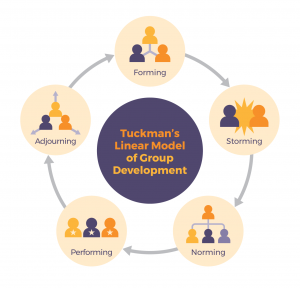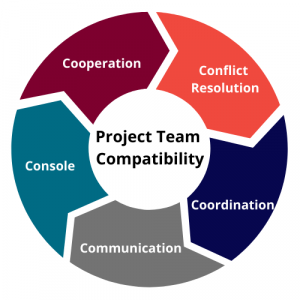Chapter 4 – Project Team
4.3. Developing Team
The project team works with the project manager to develop the project management plans, schedule the work of the project, acquire the needed resources, monitor project progress and see the project through to its successful completion. Team members may be devoted solely to working on the management aspects of a project or may also be performing the project’s work. How well the project team works together will determine the success or failure of a project.
Along with the Project Manager, the Human Resources Professional has a responsibility to ensure the development of the project team.
Watch this video: PMP Project Human Resource Management Overview | Processes in project human resource management by Kavin Kumar below.
Video: “63. PMP| Project Human Resource Management overview | Processes in project human resource management” by Kavin Kumar [1:36] is licensed under the Standard YouTube License.Transcript and closed captions available on YouTube.
HR in Focus: Team Development
Human Resources Specialists may work with the Project Manager to help recruit, develop, and monitor the team. In managing projects, HR will want to review the strategic plan first with the team. HR can support the team to get organized in the following ways:
- Define the purpose of the team and project. The team needs to know the overall purpose and goals. The HR Specialist can help them set goals within the project.
- Measure the team’s performance. The project manager and the HR Specialist can discuss and establish metrics and reporting of metrics related to performance. These measurements would be discussed with the team to ensure success. The HR Specialist can help to monitor performance throughout the project.
- Reward the team. HR Specialists can set up reward systems that are linked to the goals of the project, which helps to motivate the team for success.
Team Building Exercises
HR Specialists can help project managers and teams develop team skills through various activities and exercises. This assists with the development of interpersonal relationships, collaboration and cooperation between the team members, and the team and the project manager.
There are many different types of team-building exercises. Some things to consider may be:
- Goal setting: The team, along with the project manager, plans a simple project with goals, outcomes, and measures of success.
- Role definition: Each team member is given a defined role within a team challenge and plays out the role.
- Communication exercises: The team designs a presentation and delivers the presentation.
- Problem-solving exercises: The team is given a challenge, i.e. to plan a trip into space. They must work together to plan the trip and include all the resources needed to survive the trip.
HR plays a significant role in building team collaboration to influence the success of projects positively.
Team Member Motivation
Regarding how project managers may view the motivation of team members, let’s take a look at what motivates individuals, teams, and organizations.
Maslow’s Hierarchy of Needs
Abraham Maslow provided a model to understand basic human needs, usually represented as a pyramid (see Figure 13-1). Each need builds on the others: A person’s esteem needs are not that important if they are struggling with meeting the biological need to eat. Here are each of the levels in Maslow’s hierarchy:
- Biological and Physiological: What a person needs to survive, such as food, water, and shelter.
- Safety: The need to be safe in your person, have financial security, and protection against accidents and illness.
- Love and Belongingness: The need to be loved by one’s family and community.
- Esteem: The need to be respected and valued by others.
- Self-Actualization: At the top of the pyramid is the desire to become the best version of yourself that you can. For example, working hard to become the best artist, parent, or project manager you can become.

For project managers, this model is useful in several ways. It explains why team members who have problems with their health, family relations or other “lower” needs will have a problem performing their best on the job. Project managers will also try to meet the esteem needs of their team members by acknowledging their contributions and celebrating successes. This can be an award formally presented at a celebration dinner or a simple email expressing thanks. Anecdotally, it doesn’t seem that the size or formality of the acknowledgement matters much; what is important is that it is given sincerely.
Understanding Team Development
Several management professionals and academics have studied project team development. Let’s review the model that PMI considers the most valuable in understanding team development: Tuckman’s Stages of Team Development. Dr. Bruce Tuckman (1965) observed that teams go through a series of developmental stages: Forming, Storming, Norming, Performing, and Adjourning. Each stage has predictable characteristics.
- Forming: The group is brought together for the first time. The team is orienting themselves to the task at hand. At this stage, there may be little agreement on how to approach the project and team members may struggle with understanding the purpose of the project. The project manager needs to provide guidance and direction during this stage.
- Storming: Team members are trying to figure out their roles in the group. Conflict and power struggles are common, but so is a clearer vision for the group. During this time of intergroup conflict, the project manager needs to provide support and coaching.
- Norming: At this stage, the team will have developed a consensus regarding roles, processes and approaches to the work ahead. The project manager should participate by working as a facilitator for the group.
- Performing: At this point, the group has a clear vision and purpose and is focused on meeting performance goals, project milestones and other benchmarks. The project manager should be able to delegate more and more responsibility to the team with less supervision.
- Adjourning: Once the project is completed, the team should collect lessons learned and transition to other projects or roles. The project manager should provide recognition of the work done by the team and help them transition to their next project (provide recommendations, etc).

Fast-Tracking Team Development
Project managers who can quickly move the team from the Forming stage to the Performing stage will have considerable advantages in terms of performance. To do this, project managers incorporate team-building activities into the project. Starting the project with some team-building activities will let the team start to form, resolve interpersonal conflicts and develop norms of behaviour in a low-risk environment.
Unfortunately, some project managers perceive taking time for team building as a waste of time. However, the time invested here pays off with a much more motivated and better-performing team. There are lots of opportunities to incorporate team-building activities into the planning process. Perhaps the most important process a project manager can facilitate is helping team members learn to trust each other.
Human Resources and Team Project Development
The characteristics and behaviours of teams are important to project success. It is important to choose effective teams that reflect good team compatibility.

Cooperation: Willing and able to work together for the good of the project. They are willing to share resources, be flexible, accommodate each other’s needs and meet deadlines.
Communication: They can relay information clearly and concisely and be good listeners when discussing project goals, outcomes, and tasks to be performed.
Coordination: They need to work together on the project to “keep things on track” and integrate each other’s work into the daily outcomes.
Console: They need to maintain positive attitudes and, be mentally and psychologically stable, and support each other to be and do the same. They must be empathic, soothe each other, and help each other build self-esteem and self-confidence in the project duties.
Conflict resolution: They need the skills to motivate and resolve conflict. Disagreements are part of any project, as each member has different ideas on how to perform tasks in the project. Effective team members can discuss issues, brainstorm ideas for resolution, and continue work in harmony.
Human Resource Specialists are skilled in identifying these compatibility skills and talents. They can support the hiring, along with the Project Manager, to ensure the team members are mutually accountable to each other.
“13.3. Developing Team” from Essentials of Project Management by Adam Farag is licensed under a Creative Commons Attribution-NonCommercial-ShareAlike 4.0 International License, except where otherwise noted.

